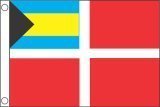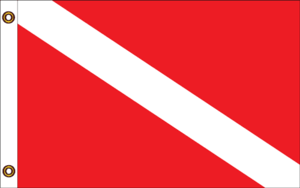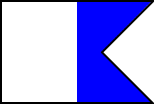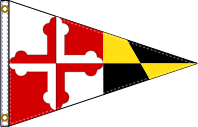|
A few basic terms are in
order: Whatever a flag's shape, its vertical dimension is its hoist, and its
horizontal extent is its fly. The main part of the flag is called either the
field or ground; the upper left quarter of the flag is known as the canton or
the union.
There are several types
of flags that concern the yachtsman. First and most important are the national
colors, often called the ensign. We commonly refer to the nation's flag in the
plural, but when one talks about "making colors," the phrase normally includes
several flags, one of them the national ensign.
Next most common aboard
yachts is the burgee, a usually triangular flag that denotes membership in a
yacht club or other local boating organization.
In the U.S., an owner's
individual flag is called a private signal, while in Britain it is sometimes
referred to as a house flag. In either case, it is most often a swallowtail
shape, although triangles and rectangles are not uncommon.
Related to the private
signal is the organizational officer's flag - yacht club commodore, Coast Guard
Aux. Flotilla Commander, etc. Incompatible combinations are officers' flags from
one club displayed with burgees from another or two burgees raised at once.
Seldom seen aboard
yachts, the Union Jack is a national flag that derives from naval usage.
In the U.S. it is the 50 star union of the national
flag, displayed only at a vessel's bow or jack staff, only at anchor or tied up,
and only on Sundays or holidays.
There are also numerous
signal flags serving more or less useful purposes, from the oversize Race
Committee banners seen at regattas to the International Code flags to the
various gag flags suggesting the presence of booze, lust or terminal bad taste
aboard the vessel hoisting them.
Single masted sailboats
normally have three possible locations from which to display flags - the
masthead, the starboard spreader and aft (the mainsail leech or the stern
staff). Underway under sail alone, the traditional recipe has been that the
burgee appears at the masthead and the ensign at the gaff or two-thirds the way
up the leech of the main. An organizational flag, a courtesy flag when in
foreign waters or a signal may appear at the spreader hoist.
The
ensign has migrated from the mainsail leech to the stern staff,
a move formally recognized in the early '70s by both the New York YC and the
USYRU. Purists resisted the change, but it seems safe to say that a vast
majority of Bermudian sloops now carry their ensigns at the stern under sail or
power.
Another change that's
taking place - albeit unrecognized by any authority - but now apparently
standard, is the descent of the burgee from
the masthead to the starboard spreader. Now
that most mastheads have become electronics forests, it has become not only
difficult but potentially expensive to plant a flag among all the delicate
feelers.
When a single masted
sailing yacht is underway under power, or a combination of power and sail,
former usage called for the ensign to be removed from gaff or leech and reappear
on the stern staff. Now, the ensign is normally flown from the stern staff.
At anchor, under normal
circumstances, the flag conformation is the same as under power. On festive
occasions the boat may also be dressed overall with the flags and pennants of
the International Code.
The flag usage aboard
yawls is essentially the same as aboard single-masted sailing yachts, except
that the mizzen offers a third possible location for the ensign, as it can be
carried on the leech (normally about 2/3 up the leech).
Although today's tendency
seems to be to hoist as many flags as one can possibly fit on the boat, each of
them is likely to be too small for the purpose. Barring absurd extremes,
however, a large flag generally looks better than a
small one, and the rule of thumb for size ought really to be
considered a minimum.
That rule calls for
the ensign to be one inch on the fly for each foot of
boat length overall. The burgee, house flag and officer's flag are half
an inch on the fly for each foot above water of the highest truck,
for sailing yachts and auxiliaries. The courtesy flag
used in foreign waters is normally half the size of the yachts own ensign,
but flags intended as meaningful signals - Code signals, etc. - should be as
large as can conveniently carried.
The
basic rule is that colors are made at 0800 local time and at sunset.
Flags may be displayed before or after the hours for colors when entering or
leaving port.
When a
yacht visits foreign waters, custom calls for her to hoist the courtesy flag.
Many countries have more than one national flag, and
the proper courtesy flag is a half-sized version of the nation's yacht or
merchant vessel ensign. In Canada, the national flag is flown on
ships and yachts and also by visitors. As a matter of politeness, the courtesy
flag occupies a place in the hierarchy second only to the vessel's own national
ensign, but it is primarily a signal, and thus takes the position normally
reserved for that sort of flag. On sailing or masted power yachts, this is
usually at the forward starboard spreader.
The foreign-going yachtsman is well advised to keep an eye on what other
visiting yachts are doing, and follow their example.
On festive occasions a
vessel fully dressed in flags and pennants of the International Code adds a
colorful touch to any harbor.
A yacht dressed overall
wears the flags she would normally hoist under the circumstances, as well as the
39 code flags. Since there are 26 square alphabet, three triangular repeater
pennants and 10 truncated pennants representing numerals, normal procedure calls
for alternating two letters with every number or repeater. There is no absolute
arrangement. The arrangement is supposed to run in an unbroken arch from
waterline to waterline, which means that two flags will almost touch the water.
In summary, on a larger
sailing yacht, there are five or sometimes six places from which flags may be
flown: a) the stern staff (national ensign under power or under sail); b) the
leech of the aftermost sail (national ensign under sail); c) main or foremast
truck (yacht club burgee, or, in the case of a single masted vessel, the owner's
private signal or officer's flag); d) mizzen truck (owner's private signal or
flag officer's flag); e) forward starboard spreader (organizational flag other
than burgee, courtesy flag when in foreign waters); and f) the bow or jack staff
(Union Jack at anchor on Sundays or holidays).
Further reading:
How to fly flags,
Canadian Power & Sail Squadron
Flags,
Nautical Know How
|








